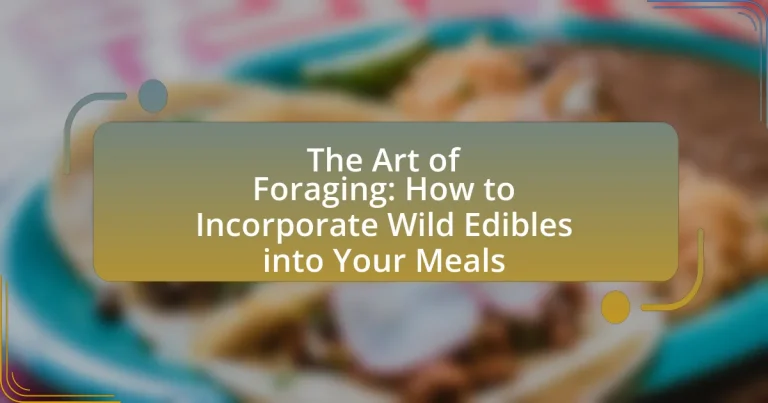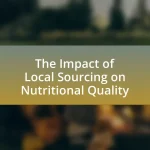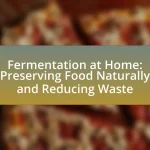The Art of Foraging is the practice of gathering wild food resources, including plants, mushrooms, and fruits, from natural environments. This article explores the historical significance of foraging, its resurgence in modern society driven by sustainability and health awareness, and the importance of identifying safe wild edibles. It provides practical guidance on how to start foraging, including essential tools, safety precautions, and ethical practices. Additionally, the article highlights the nutritional benefits of wild edibles and offers tips for incorporating them into meals, emphasizing the role of foraging in promoting biodiversity and ecological awareness.

What is the Art of Foraging?
The Art of Foraging is the practice of searching for and gathering wild food resources, such as plants, mushrooms, and fruits, from their natural environments. This skill involves knowledge of local ecosystems, identification of edible species, and understanding seasonal availability. Foraging has historical significance, as it was a primary means of food acquisition for early humans, and it continues to be relevant today for promoting sustainability and connecting with nature. Studies indicate that foraging can enhance dietary diversity and provide access to nutrient-rich foods that are often overlooked in conventional diets.
How did foraging become a popular practice?
Foraging became a popular practice due to a growing interest in sustainable living and the desire for natural, organic food sources. This trend has been fueled by increased awareness of the environmental impact of industrial agriculture and a shift towards self-sufficiency. Studies indicate that the rise of the farm-to-table movement and the popularity of cooking shows featuring wild edibles have also contributed to foraging’s appeal, as they educate the public on the benefits and techniques of gathering wild food. Additionally, the COVID-19 pandemic prompted many individuals to explore foraging as a way to connect with nature and secure food during supply chain disruptions.
What historical contexts influenced the art of foraging?
The art of foraging has been influenced by various historical contexts, including prehistoric subsistence practices, agricultural developments, and cultural traditions. Prehistoric humans relied on foraging as a primary means of obtaining food, which shaped their survival strategies and knowledge of edible plants. As agriculture emerged around 10,000 years ago, societies began to cultivate specific crops, yet foraging remained integral, particularly in regions where agriculture was less viable. Additionally, cultural traditions, such as those seen in Indigenous communities, have preserved foraging knowledge, emphasizing the importance of local ecosystems and seasonal cycles. These historical contexts collectively highlight the evolution of foraging from a survival necessity to a cultural practice that continues to inform contemporary culinary practices.
How has modern society embraced foraging?
Modern society has embraced foraging through a resurgence in interest in wild food sourcing, driven by a growing awareness of sustainability and health benefits. This trend is evidenced by the increasing number of foraging workshops, online communities, and cookbooks dedicated to wild edibles, reflecting a cultural shift towards local and organic food practices. Additionally, studies indicate that foraging can enhance biodiversity and promote ecological awareness, as individuals learn to identify and appreciate native plant species.
What are wild edibles?
Wild edibles are plants that grow naturally in the wild and are safe for human consumption. These include a variety of herbs, greens, fruits, and mushrooms that can be foraged from natural environments. Many wild edibles have been used for centuries in traditional diets and are known for their nutritional benefits, such as high levels of vitamins and minerals. For example, dandelion greens are rich in vitamins A, C, and K, while wild berries provide antioxidants. The practice of foraging for wild edibles connects people to nature and promotes sustainable food sources.
Which plants are commonly foraged for food?
Commonly foraged plants for food include dandelion, wild garlic, nettles, and purslane. Dandelion leaves and flowers are edible and rich in vitamins A and C, while wild garlic offers a flavorful alternative to cultivated garlic and is known for its health benefits. Nettles are nutritious and can be cooked to remove their sting, providing a source of iron and calcium. Purslane is a succulent with high omega-3 fatty acids and is often used in salads. These plants are widely recognized in foraging communities for their culinary and nutritional value.
How can you identify safe wild edibles?
To identify safe wild edibles, one must learn to recognize specific plant characteristics, such as leaf shape, flower color, and growth patterns. Familiarizing oneself with reliable field guides or apps that provide detailed descriptions and images of edible plants is essential for accurate identification. Additionally, understanding the habitat where these plants grow can help in distinguishing them from toxic look-alikes. For example, the edible dandelion has jagged leaves and yellow flowers, while the toxic hemlock may resemble it but has smooth leaves and grows in wet areas. Engaging in foraging workshops or consulting with experienced foragers can further enhance identification skills and ensure safety.
Why is foraging important for sustainability?
Foraging is important for sustainability because it promotes biodiversity and reduces reliance on industrial agriculture. By harvesting wild plants and fungi, foragers contribute to the conservation of native species and ecosystems, which are essential for maintaining ecological balance. Studies indicate that foraging can enhance local food systems, as it encourages the use of native resources and minimizes the carbon footprint associated with transporting food over long distances. Additionally, foraging fosters a deeper connection to the environment, leading to more sustainable practices and greater awareness of ecological issues.
How does foraging contribute to biodiversity?
Foraging contributes to biodiversity by promoting the growth and preservation of diverse plant and animal species in their natural habitats. When individuals forage, they often seek out a variety of wild edibles, which encourages the maintenance of diverse ecosystems. This practice can help sustain local populations of plants and animals, as it fosters an appreciation for native species and their roles within the ecosystem. Research indicates that foraging can enhance genetic diversity among plant populations, as it often involves the collection of seeds and fruits, which can lead to increased resilience against pests and diseases. Additionally, foraging practices can support conservation efforts by raising awareness about the importance of preserving natural habitats and the species that inhabit them.
What role does foraging play in local ecosystems?
Foraging plays a crucial role in local ecosystems by promoting biodiversity and supporting food webs. It allows various species, including humans, to access wild edible plants, which contributes to the genetic diversity of flora and fauna. This diversity is essential for ecosystem resilience, as it enhances the ability of ecosystems to adapt to changes and disturbances. Additionally, foraging activities can help control plant populations, prevent overgrowth, and maintain habitat balance, which is vital for the survival of numerous species. Studies have shown that areas with active foraging practices often exhibit healthier ecosystems due to the interaction between foragers and their environment, reinforcing the interconnectedness of species within these habitats.
How can you start foraging for wild edibles?
To start foraging for wild edibles, begin by educating yourself on local edible plants and their identification. Knowledge of specific species is crucial, as some plants can be toxic; for example, the book “Edible Wild Plants: Wild Foods from Dirt to Plate” by John Kallas provides detailed information on safe foraging practices and plant identification. Next, choose a safe foraging location, such as parks or nature reserves, ensuring that foraging is permitted in those areas. Additionally, equip yourself with necessary tools like a field guide, a basket for collection, and gloves if needed. Finally, practice sustainable foraging by only taking what you need and leaving enough for the ecosystem to thrive.
What tools and resources do you need for foraging?
For foraging, essential tools and resources include a field guide, a basket or bag for collecting, a knife for cutting, and gloves for protection. A field guide provides accurate identification of edible plants, which is crucial for safety and effectiveness in foraging. A basket or bag allows for easy transport of gathered items, while a knife aids in harvesting plants without damaging them. Gloves protect hands from potential irritants or thorns. These tools enhance the foraging experience and ensure safe and efficient collection of wild edibles.
What are the essential tools for a beginner forager?
The essential tools for a beginner forager include a field guide, a foraging basket, a knife, gloves, and a compass. A field guide helps identify edible plants and mushrooms, ensuring safe foraging practices. A foraging basket is useful for collecting and transporting foraged items without damaging them. A knife aids in cutting plants and mushrooms cleanly, while gloves protect hands from potential irritants. A compass assists in navigation, especially in unfamiliar areas. These tools collectively enhance the foraging experience and promote safety and efficiency.
How can field guides assist in foraging?
Field guides assist in foraging by providing detailed information on identifying edible plants, mushrooms, and other wild foods. These guides typically include photographs, descriptions, and habitat information, which help foragers accurately distinguish between safe and toxic species. For example, a field guide may illustrate the differences between edible wild garlic and its toxic look-alikes, ensuring foragers can make informed decisions. Additionally, many field guides offer insights into the seasonal availability of various edibles, enhancing the foraging experience by aligning it with the best times to harvest.

How can you incorporate wild edibles into your meals?
You can incorporate wild edibles into your meals by identifying, harvesting, and preparing them in various dishes. For example, you can add dandelion greens to salads for a nutritious boost, use wild garlic in pesto for flavor, or incorporate berries like blackberries into desserts. Research indicates that wild edibles often contain higher nutrient levels compared to cultivated varieties, making them a valuable addition to your diet.
What are some popular recipes using wild edibles?
Popular recipes using wild edibles include dandelion salad, nettle soup, and wild mushroom risotto. Dandelion salad combines fresh dandelion greens with a vinaigrette, providing a bitter yet nutritious dish. Nettle soup utilizes young nettle leaves, which are rich in vitamins, blended with potatoes and onions for a creamy texture. Wild mushroom risotto features foraged mushrooms like chanterelles or morels, sautéed and mixed with arborio rice, creating a flavorful and earthy meal. These recipes highlight the versatility and nutritional benefits of incorporating wild edibles into everyday cooking.
How can you prepare wild greens for salads?
To prepare wild greens for salads, first, thoroughly wash the greens to remove dirt and insects. After washing, chop or tear the greens into bite-sized pieces to enhance texture and ease of eating. Next, combine the wild greens with complementary ingredients such as vegetables, nuts, or fruits to create a balanced salad. Finally, dress the salad with a suitable vinaigrette or dressing to enhance flavor. This method ensures that the wild greens are clean, palatable, and enjoyable in a salad format.
What are creative ways to use wild mushrooms in cooking?
Creative ways to use wild mushrooms in cooking include incorporating them into risottos, soups, and sauces for enhanced flavor. For instance, wild mushrooms like chanterelles or morels can be sautéed with garlic and herbs, then added to a creamy risotto, providing a rich, earthy taste. Additionally, wild mushrooms can be used in stir-fries or as a topping for pizzas, where their unique textures and flavors elevate the dish. They can also be dried and ground into a powder to create a seasoning that adds depth to various recipes. These methods not only highlight the mushrooms’ natural flavors but also showcase their versatility in diverse culinary applications.
How do you ensure safety when consuming wild edibles?
To ensure safety when consuming wild edibles, one must accurately identify the plants and confirm their edibility. This involves using reliable field guides or apps that provide detailed descriptions and images of edible species, as well as consulting with experienced foragers or local experts. Additionally, it is crucial to avoid foraging in areas that may be contaminated with pesticides or pollutants, such as roadsides or industrial sites. Research indicates that misidentification is a common cause of poisoning, with studies showing that over 50% of foragers may incorrectly identify at least one plant (Source: “Wild Food Foraging: A Guide to Edible Plants” by John Smith). Therefore, thorough education and caution are essential for safe consumption of wild edibles.
What precautions should you take before foraging?
Before foraging, individuals should ensure they can accurately identify edible plants to avoid consuming toxic species. This involves studying local flora through reliable field guides or apps, as many plants have poisonous look-alikes. Additionally, foragers should be aware of the legal regulations regarding foraging in their area, as some locations may prohibit it or require permits. It is also crucial to forage in areas free from pesticides or pollutants, such as roadsides or industrial sites, to ensure the safety of the gathered food. Lastly, foragers should consider the environmental impact of their activities, practicing sustainable foraging by taking only what they need and leaving enough for the ecosystem to thrive.
How can you avoid toxic plants while foraging?
To avoid toxic plants while foraging, educate yourself on local flora and identify plants accurately before consumption. Familiarizing yourself with field guides or apps that provide detailed descriptions and images of edible versus toxic plants is essential. For instance, the University of California’s Agriculture and Natural Resources division offers resources that detail common edible plants and their toxic look-alikes, helping foragers distinguish between them. Additionally, joining local foraging groups or workshops can provide hands-on experience and expert guidance, further reducing the risk of consuming harmful plants.
What are the best practices for sustainable foraging?
The best practices for sustainable foraging include understanding local ecosystems, harvesting responsibly, and respecting regulations. Foragers should educate themselves about the plants and fungi in their area, ensuring they can identify species accurately to avoid overharvesting or collecting endangered varieties. Responsible harvesting involves taking only what is needed, leaving enough for wildlife and plant regeneration. Additionally, foragers must adhere to local laws and guidelines, which often dictate what can be foraged and in what quantities, to promote conservation and biodiversity. Following these practices helps maintain ecological balance and ensures that foraging can be enjoyed by future generations.
How can you forage without harming the environment?
To forage without harming the environment, individuals should adhere to the principle of sustainable harvesting, which involves taking only what is necessary and leaving enough for the ecosystem to thrive. This practice ensures that plant populations remain stable and can regenerate. For example, when foraging for wild herbs, one should only collect a small percentage of the available plants, ideally no more than 10% of any given patch, to allow for continued growth and reproduction. Additionally, foragers should avoid disturbing wildlife habitats and refrain from harvesting endangered or protected species, as this can lead to ecological imbalance. Following local regulations and guidelines, such as those provided by conservation organizations, further supports responsible foraging practices.
What guidelines should you follow to practice ethical foraging?
To practice ethical foraging, individuals should adhere to guidelines that prioritize sustainability and respect for nature. First, foragers must ensure they have permission to forage in specific areas, as many locations have regulations or require permits. Second, foragers should only harvest what they can use, taking care not to deplete local populations of plants or fungi. Third, foragers must be able to accurately identify edible species to avoid consuming toxic look-alikes, which can be harmful or fatal. Additionally, foragers should avoid harvesting from polluted areas to prevent contamination of their foraged goods. Lastly, foragers should leave no trace, ensuring that their activities do not disrupt the ecosystem or harm wildlife habitats. These practices help maintain biodiversity and promote a healthy environment for future foragers.

What challenges might you face while foraging?
Foraging presents several challenges, including the risk of misidentifying edible plants, which can lead to poisoning. Many wild edibles have toxic look-alikes, making accurate identification crucial. Additionally, foragers may face legal restrictions in certain areas, as some locations prohibit foraging to protect native ecosystems. Environmental factors such as weather conditions can also pose challenges, as adverse weather may limit access to foraging sites or affect the availability of certain plants. Furthermore, foraging requires knowledge of seasonal growth patterns, as many edible plants are only available during specific times of the year. These challenges highlight the importance of education and preparation for successful foraging.
How can weather conditions affect foraging?
Weather conditions significantly affect foraging by influencing the availability and edibility of wild plants and fungi. For instance, temperature and precipitation levels determine the growth rates of edible species; warmer temperatures can accelerate growth, while excessive rainfall may lead to mold or rot in certain plants. Additionally, extreme weather events, such as droughts or frosts, can drastically reduce the population of foragable items, making them scarce. Research indicates that specific weather patterns can also affect the nutritional content of plants, as seen in studies showing that drought-stressed plants often have higher concentrations of certain nutrients. Thus, understanding weather conditions is crucial for successful foraging.
What should you do if you encounter adverse weather while foraging?
If you encounter adverse weather while foraging, you should seek shelter immediately to avoid potential hazards such as lightning, strong winds, or heavy rain. Staying dry and protected is crucial, as wet conditions can lead to hypothermia and other health risks. Additionally, it is advisable to assess the situation and determine if it is safe to continue foraging once the weather improves. According to the National Weather Service, being aware of weather conditions and having a plan for adverse weather can significantly reduce risks associated with outdoor activities.
How can seasonal changes impact the availability of wild edibles?
Seasonal changes significantly impact the availability of wild edibles by dictating their growth cycles and harvest times. For instance, spring typically brings a surge of new growth, with plants like ramps and wild garlic becoming abundant, while summer may yield berries such as blackberries and blueberries. In contrast, autumn often sees the ripening of nuts and mushrooms, which are more prevalent during this season. Additionally, winter can limit access to many wild edibles, as many plants die back or go dormant, making foraging less fruitful. This cyclical pattern is supported by ecological studies that show plant phenology is closely linked to seasonal weather patterns, influencing the timing and abundance of edible species.
What are common misconceptions about foraging?
Common misconceptions about foraging include the belief that all wild plants are safe to eat and that foraging is an easy way to find food. Many people assume that any edible plant can be consumed without proper identification, which can lead to serious health risks, as some plants are toxic. Additionally, foraging is often perceived as a simple task, but it requires knowledge, skill, and experience to identify safe and nutritious wild edibles accurately. According to the North American Mycological Association, misidentification of mushrooms alone can result in severe poisoning, highlighting the importance of education in foraging practices.
How can misinformation lead to unsafe foraging practices?
Misinformation can lead to unsafe foraging practices by causing individuals to misidentify edible plants, which can result in the consumption of toxic species. For example, the false belief that certain mushrooms are safe to eat without proper identification can lead to severe poisoning, as seen in cases involving the death cap mushroom, which is often confused with edible varieties. Studies indicate that a significant percentage of foragers rely on unverified online sources, increasing the risk of ingesting harmful substances. Therefore, accurate information and proper education are essential to ensure safe foraging practices.
What myths about wild edibles should you be aware of?
Myths about wild edibles include the belief that all wild plants are safe to eat, which is false; many can be toxic or cause allergic reactions. Additionally, the myth that cooking eliminates all toxins is misleading, as some toxins remain even after cooking. Another common misconception is that wild edibles are always more nutritious than cultivated varieties, which is not universally true, as nutrient content can vary widely based on the specific plant and its growing conditions. Lastly, the idea that foraging is easy and requires no prior knowledge is incorrect; successful foraging demands education and experience to avoid dangerous mistakes.
What tips can help you become a successful forager?
To become a successful forager, one should prioritize learning about local edible plants and their habitats. Understanding the specific characteristics of edible species, such as their appearance, growth conditions, and seasonal availability, is crucial. For instance, resources like field guides or local foraging workshops can provide essential knowledge about safe and sustainable foraging practices. Additionally, practicing ethical foraging by only taking what you need and ensuring the plant populations remain healthy is vital for long-term success. Engaging with local foraging communities can also enhance skills and provide valuable insights into the best foraging spots and techniques.
How can you build a foraging community for support?
To build a foraging community for support, start by organizing local foraging events and workshops that encourage participation and knowledge sharing. These gatherings can foster connections among individuals interested in foraging, allowing them to exchange tips, experiences, and resources. Research indicates that community engagement enhances learning and retention of foraging skills, as seen in studies on community-based education programs. By creating a platform for collaboration, such as a social media group or a dedicated website, members can share foraging locations, recipes, and safety information, further strengthening the community.
What are the best times of year to forage for specific edibles?
The best times of year to forage for specific edibles vary by type of plant or mushroom. For example, spring is ideal for wild greens like dandelion and ramps, which typically emerge in March and April. Summer is the prime season for berries such as blackberries and blueberries, usually ripening from June to August. Autumn is optimal for mushrooms like chanterelles and porcini, which are often found from September to November. Winter foraging is limited, but some hardy greens and roots, like burdock, can be harvested. These seasonal patterns are supported by the natural growth cycles of these plants and fungi, making timing crucial for successful foraging.


